Merlins Bridge is situated just south of the County Town of Haverfordwest, on the road to Milford Haven. The War Memorial takes the form of a marble column, and commemorates the men of the village who died in both world wars.
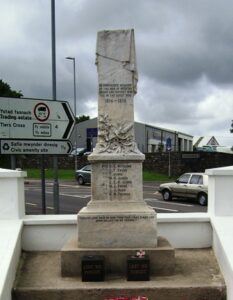
The Great War, 1914-1918
Alfred Thomas Evans, Lance Corporal, S/11676, Rifle Brigade. Alfred was born in Little Haven, the son of Thomas and Margaret Evans. He married Gertrude Annie Richards in 1914, and the couple resided at Merlins Bridge. Alfred enlisted at Haverfordwest into the 1st Battalion, Rifle Brigade, which was attached to 11 Brigade, 4th Division. The division was one of the first Divisions to move to France, arriving just in time to join II Corps at The Battle of Le Cateau. They then took part in the epic retreat to the Marne, where the German Offensive was halted, and in the advance to the Aisne. The Division was then moved north to Flanders, and took part in the Battle of Messines, where Units of 4th Division took part in the famous Christmas Truce while they were still in this area, in trenches near Ploegsteert Wood. In 1915 the Division fought at the Second Battle of Ypres, and in the summer of 1916 were on the Somme, where they were one of the first Divisions into battle, going over the top on 1 July 1916. Alfred was one of 20,000 men who were killed in the first few hours of the Battle of the Somme that day. He was 22 years old, and is buried in Serre Road Cemetery, No. 2, France.
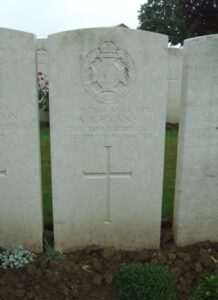
William John Evans, Private, 28621, Welsh Regiment. William was born at Haverfordwest. He enlisted into the Welsh Regiment, and was posted to France, where he joined the 2nd Battalion, Welsh Regiment, which was attached to 3 Brigade, 1st Division. William probably joined the battalion around the end of 1915, at Loos. They moved south to the Somme, where they fought throughout the Somme Offensive. They followed the German retreat to the Hindenburg Line in early 1917, and were then briefed for an operation on the Flanders Coast, and moved there during the Summer of 1917. While training on the coast, the Battle of Third Ypres had stalled in the mire, and the Division were recalled to Ypres, where they fought at the Second Battle of Passchendaele. After spending another winter in Flanders, they were near Estaires when the German Spring Offensive caught them, fighting through the Battles of Estaires, and of Hazebrouck. William was killed in action during the Battle of Hazebrouck, on 17 April 1918. He has no known grave and is remembered on the Loos Memorial, France.
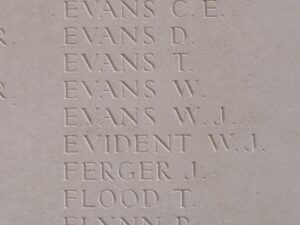
William Gilmore, Private, 16411, South Wales Borderers. William was the foster son of Mr. and Mrs. George Griffiths, of Peep Out, Little Milford, Haverfordwest. He served with the 8th Battalion, South Wales Borderers, which was attached to 67 Brigade, 22nd Division. The Division crossed to France in September 1915, however its stay in France was very short, as on 27 October 1915 the Division, having been moved by train to Marseilles, began to embark for Salonika, completing concentration there in November 1915. It remained in the theatre for the rest of the war, taking part in the Retreat from Serbia during December 1915. During August 1916 they fought at the battle of Horseshoe Hill, then in September 1916 at the battle of Machukovo. William died at Salonika on 26 September 1916. He is buried in Salonika (Lembet Road) Military Cemetery. William is not commemorated locally.
John Elliott James, Private, 31589, South Wales Borderers. John was born in 1899, the son of Thomas and Emily James, of Merlins Hill, Haverfordwest. He enlisted there into the 6th Battalion, South Wales Borderers, which was attached to the 25th Division as Pioneers. The Division landed in France on 26 September 1915, and was posted to the Vimy area, where they defended Vimy Ridge against a German attack in May 1916. They then moved to the Warloy area and attacked on the 3rd July near Thiepval. They fought throughout the Battle of the Somme, and then moved to Ploegsteert, where they held the line for the months leading up the Battle of Messines in June 1917. After fighting at Messines, the Division moved north, and fought at Pilckem, before moving south again, where they took up positions around Bullecourt in reserve. Here the Division was used to reinforce the badly depleted British units that were hit in the area by the German Spring Offensive. John was wounded here, and died of wounds on 28 March 1918, aged 19. He is buried in St. Hilaire Cemetery, Frevent, France.
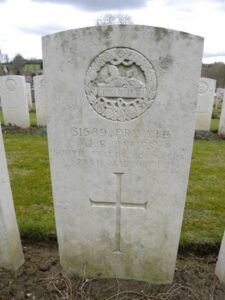
William Hubert James, Private, 36053, Royal Warwickshire Regiment. William was the son of Richard and Mary James, of Barnsley, Redhill, Haverfordwest. He enlisted there into the Cheshire Regiment with the Regimental Number 4/9038, and later transferred into the 16th Battalion, Royal Warwickshire Regiment, which was attached to the 5th Division. The Division had been on the Western Front since the early days of the war, and had fought throughout most of the major Battles. On 14 August 1918, the Division was withdrawn for rest and placed in GHQ Reserve, after months of heavy fighting. Two weeks later it entered into what became a series of complex, endless, overlapping Allied attacks that forced the German Army into retreat. Fighting through Albert (back on the old and devastated Somme ground of 1916), the Division was in more or less continuous action until late October 1918, fighting at the Battle of Albert, the Battle of Bapaume, the Battle of Epehy, and the Battle of the Canal du Nord. William was killed in action during the Battle of the Selle, on 21 October 1918, aged 19. He has no known grave, and so is remembered on the Vis-En-Artois Memorial, France.
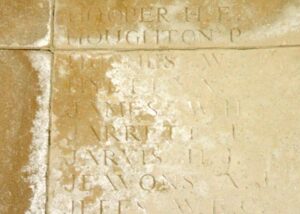
Edwin Arthur John, Private, 624939, Canadian Expeditionary Force. Edwin was born at Derby Farm, near Merlins Bridge, on 11 April 1893, the son of Arthur and Jane John. The family emigrated to Canada in 1904, embarking from Liverpool aboard SS Bavarian on 22 September, and arrived at Montreal. They then set up home at Erskine, Alberta, before moving on to Turgoose, British Columbia. Edwin enlisted into the Canadian Infantry at Stettler, Alberta, on 22 February 1916, and joined the 151st Overseas Battalion, CEF. Edwin then travelled to Britain, where he joined the reinforcements for the 50th Alberta Regiment, which was attached to the 10th Canadian Brigade, 4th Canadian Division. The battalion arrived in France in August 1916, and fought through the later Battles on the Somme in 1916. In April 1917 it took part in the Battle of Vimy Ridge, and remained on the Arras front afterwards, where it took part in The Battle of Hill 70. On 25 August 1917 the 50th Battalion was tasked with the capture of Aloof Trench. Edwin and his brother John were both killed here that day, on 25 August 1917, when Edwin was hit by a sniper during the assault. John fell while cradling the body of his dead brother. Edwin was 24 years old, and is commemorated alongside his brother on the Vimy Memorial, France.
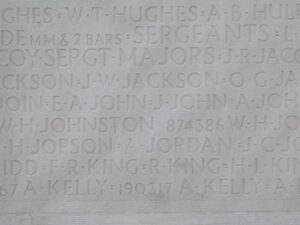
James John, Private, 883636, Canadian Expeditionary Force. James was born at Derby Farm, near Merlins Bridge, on 17 July 1888, the son of Arthur and Jane John. The family emigrated to Canada in 1904, embarking from Liverpool aboard SS Bavarian on 22 September, and arrived at Montreal. They then set up home at Erskine, Alberta, before moving on to Turgoose, British Columbia. James followed the lead of his brother Edwin, and enlisted at Stettler, Alberta on 1 August 1916 into the 151st Overseas Battalion, CEF, and travelled to Britain, where he was posted to join the same battalion as Edwin, the 50th Alberta Regiment, attached to the 10th Canadian Brigade, 4th Canadian Division. The battalion arrived in France in August 1916, and fought through the later Battles on the Somme in 1916. In April 1917 it took part in the Battle of Vimy Ridge, and remained on the Arras front afterwards, where it took part in The Battle of Hill 70. On 25 August 1917 the 50th Battalion was tasked with the capture of Aloof Trench. Edwin and his brother John were both killed here that day, on 25 August 1917, when Edwin was hit by a sniper during the assault. John fell while cradling the body of his dead brother. John was 19 years old, and is commemorated alongside his brother on the Vimy Memorial, France.

Thomas Jones, Private, 1756, Welsh Guards. Thomas was the son of Stephen and Sarah Jones, of Merlin’s Bridge, Haverfordwest. He married Ada Augustus Bennett at Narberth on 14 October 1913, and they lived at Lower House, South Dairy, Clarbeston Road. The couple had two young girls. Thomas enlisted at Haverfordwest on 30 June 1915 into the 1st Battalion, Welsh Guards. The Welsh Guards was raised on 26 February 1915 by order of King George V, in order to complete the national complement of regiments of Foot Guards, and became part of 3 Guards Brigade, Guards Division. On 17 August 1915 the 1st Battalion sailed for France, and took up position in the line at Loos. They fought with great distinction at Loos through the remainder of the year, and in summer of 1916 moved to the Somme, where they fought at the Battle of Flers-Courcelette, and then at the Battle of Morval, capturing Lesboeufs Village. Thomas joined the Welsh Guards on the Somme on 31 August 1916. Sadly he was killed here on 26 September 1916, aged 26. He had no known grave, and is commemorated on the Thiepval Memorial, France.
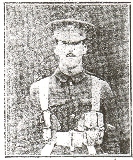
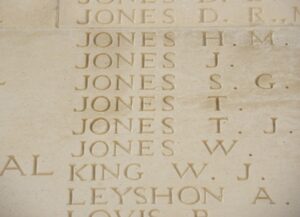
Gilbert Bowen Morgan, Private, 20621, Welsh Regiment. Gilbert was the son of Matthew and Margaret Morgan, of Green’s Farm, Merlin’s Bridge, Haverfordwest. He enlisted at Llanelli into the 15th Battalion, Welsh Regiment (Carmarthen Pals), which was attached to 114 Brigade, 38th (Welsh) Division, and moved to the Western Front in December 1915, taking up positions near Fleurbaix. They fought with distinction at Mametz Wood the following year, and in 1917 played a major part in the capture of the Pilckem Ridge during Third Ypres. They were rushed to the Somme in spring 1918 to help stem the German push towards Amiens, and then took part in the great offensive of August, 1918, where they forded the flooded River Ancre on the night of 22 August 1918 which began the great drive to victory. The Division pushed steadily through Pozieres and Longueval, capturing the village of Morval before pushing on to Sailly Saillisel, which is where Gilbert was killed on 4 September 1918. He was 26 years old, and is buried in Sailly-Saillisel British Cemetery.
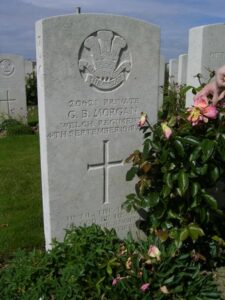
Albert John Nash, Private, 54458, Welsh Regiment. Albert was born at Towerton, Somerset in 1883, the son of Albert and Eliza Nash. He resided at Merlins Bridge prior to the war, and married Sarah Ann Absolom in 1902. The couple resided at Dredgeman Hill, where they raised at least six children. Albert enlisted at Haverfordwest into the 4th Welsh, and in 1917 was posted to France, joining the 14th Battalion, Welsh Regiment, the Swansea City Battalion, which was at Ypres attached to 114 Brigade, 38th (Welsh) Division. Albert probably took part in the divisions famous capture of the Pilckem Ridge on 31 July 1917. After seeing further action at the Battle of Langemarck, the division wintered at Armentieres, before moving south to positions around Aveluy, on the Somme. Albert was wounded here soon after. He was moved to the Hospital at Le Treport, where he died of wounds on 22 May 1918, aged 34. Albert is buried in Mont Huon Military Cemetery, Le Treport, France.
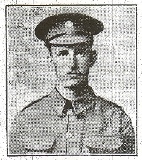
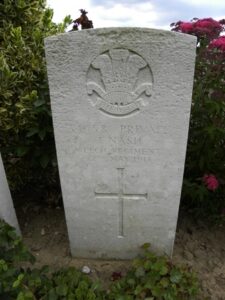
Hubert William Thomas, Private, 44378, Kings Liverpool Regiment. Hubert was originally from Martletwy, the son of John and Elizabeth Thomas. The family resided at Haroldston Mill, Haverfordwest prior to the war. Hubert enlisted there into the Welsh Regiment, with the Regimental Number 40477. Hubert then transferred into the Labour Corps, and his Number changed to 130033. This was probably after being medically downgraded. Hubert then transferred to a Labour Company of the King’s Liverpool Regiment, and remained in Britain on Home Service. He died in Hospital at Chester on 20 May 1917, aged 36, and is buried in St. Thomas A Beckett Churchyard, Haverfordwest.
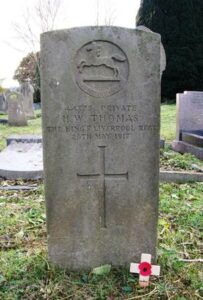
World War Two, 1939-1945
Donald Gerald Boutcher, Sergeant, 565512, Royal Air Force. Donald was the son of Walter Caleb and Euphemia Boutcher, of Merlins Bridge. He served with 211 Squadron, Royal Air Force, which was a medium bomber unit equipped with the Bristol Blenheim. In 1940 the squadron began operations against the Italians in Libya and the Western Desert, and took part in the Greek campaign. The squadron moved to the Sudan before being sent to the Far East early in 1942. Donald was captured by the Japanese at some time during the disastrous campaign in Java and Sumatra. He died as a POW on 15 April 1945, aged 29, and is commemorated on the Singapore Memorial, Singapore. Donald is not commemorated at Merlins Bridge.
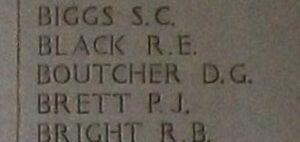
John Edwin Devonald, Engineman, LT/KX 99905, Royal Naval Patrol Service. John was the son of Edwin and Martha Elizabeth Devonald, and served as an Engineman aboard H.M. Drifter Reed. She had been Requisitioned in September 1939 as a minesweeper, and converted to an auxiliary patrol vessel in August 1940. She was sunk by a mine in Thames Estuary on 7 November 1940, killing John, who went down with the boat. He was 25 years old, and is commemorated on the Lowestoft Naval Memorial, Suffolk.
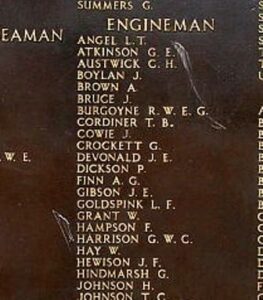
William Henry Hughes, Chief Engineer, Merchant Navy (Fishing Fleet). William was a married man, and lived at Hill Crescent, Merlin’s Bridge, Haverfordwest. He served as Chief Engineer aboard the Fishing Vessel John Baptish (Milford Haven). She was a Castle Class steel sided trawler, with coal boilers, which had been built in 1918. In 1938, she was transferred and registered at Milford Haven. The John Baptish was on a fishing trip when she disappeared, presumed mined South of Coningbeg Light Vessel, and lost with all hands on 7 September 1940. William was 41 years old when he died, and he is commemorated alongside his crewmates on the Tower Hill Memorial, London.
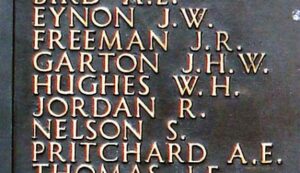
Thomas John Jones, Private, 37302, New Zealand Infantry. Thomas was the son of Thomas Frederick and Ada Jane Jones, of Merlin’s Bridge, Haverfordwest. He had emigrated to New Zealand at some time before the war. Thomas served with the 25th Battalion, New Zealand Infantry, which was attached to the 2nd New Zealand Division, and moved to North Africa in 1940. Thomas survived the Divisions desperate fighting during the defence of Crete, and was one of the men evacuated to North Africa. He was killed during the Battle of El Alamein on 22 July 1942. Thomas was 28 years old, and is buried in El Alamein War Cemetery, Egypt.